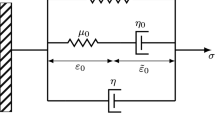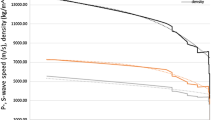Abstract
Improved differential equations of the rotation of the deformable Earth with the two-layer fluid core are developed. The equations describe both the precession-nutational motion and the axial rotation (i.e. variations of the Universal Time UT). Poincaré’s method of modeling the dynamical effects of the fluid core, and Sasao’s approach for calculating the tidal interaction between the core and mantle in terms of the dynamical Love number are generalized for the case of the two-layer fluid core. Some important perturbations ignored in the currently adopted theory of the Earth’s rotation are considered. In particular, these are the perturbing torques induced by redistribution of the density within the Earth due to the tidal deformations of the Earth and its core (including the effects of the dissipative cross interaction of the lunar tides with the Sun and the solar tides with the Moon). Perturbations of this kind could not be accounted for in the adopted Nutation IAU 2000, in which the tidal variations of the moments of inertia of the mantle and core are the only body tide effects taken into consideration. The equations explicitly depend on the three tidal phase lags δ, δ c, δ i responsible for dissipation of energy in the Earth as a whole, and in its external and inner cores, respectively. Apart from the tidal effects, the differential equations account for the non-tidal interaction between the mantle and external core near their boundary. The equations are presented in a simple close form suitable for numerical integration. Such integration has been carried out with subsequent fitting the constructed numerical theory to the VLBI-based Celestial Pole positions and variations of UT for the time span 1984–2005. Details of the fitting are given in the second part of this work presented as a separate paper (Krasinsky and Vasilyev 2006) hereafter referred to as Paper 2. The resulting Weighted Root Mean Square (WRMS) errors of the residuals dθ, sin θd \(\phi\) for the angles of nutation θ and precession \(\phi\) are 0.136 mas and 0.129 mas, respectively. They are significantly less than the corresponding values 0.172 and 0.165 mas for IAU 2000 theory. The WRMS error of the UT residuals is 18 ms.
Similar content being viewed by others
References
Aoki S. (1969) Friction between mantle and core of the Earth as a cause of the secular change in obliquity. AJ 74(2): 284–291
Bretagnon P., Francou G., Rocher P., Simon J.L. (1998) SMART97 and solution for the rotation of the rigid earth. Astron. Astroph. 329, 329–338
Dehant V., Defraigne P. (1997) New transfer functions for nutations of a nonrigid Earth. J. Geophys. Res. 102(B12): 27569–27687
Dziewonsky A.D., Andersen A.L. (1981) Preliminary reference Earth model. Phys. Earth Planet. Inter. 25, 297–356
Escapa, A., Getino, J., Ferrandiz, J. M.: Application of Poincaré’s Formalism to the free nutations of a three-layer Earth model. In: Capitaine, N. (ed.) Journées 2001, Systèmes de référence spatio-temporels, Influence of geophysics, time and space reference frames on Earth rotation studies, pp. 239–245 (2003)
Jeffreys H., Vicente R.O. (1957) The theory of nutation and variations of latitude. MNRAS 117, 14–161
Getino J., Ferrandiz J.M. (1991a) A Hamiltonian theory for an elastic earth: elastic energy of deformation. Cel. Mech. Dyn. Astron. 51(1): 17–34
Getino J., Ferrandiz J.M. (1991b) A Hamiltonian theory for an elastic earth: first order analytical integration. Cel. Mech. Dyn. Astron. 51, 35–66
Getino J., Ferrandiz J.M. (2001) Forced nutations of a two-layers Earth model. MNRAS 322(4): 785–799
Herring, T.A., Mathews, P.M., Buffet, B.A.: Modeling of nutation- precession: Very long baseline interferometry results. J. Geophys. Res., 107(B4), 10.1029/2001JB00165, 4-1–4-11 (2002)
Kinoshita H., Souchay J. (1990) The theory of the nutation for the rigid Earth model at the second order. Cel. Mech. Dyn. Astron. 48, 187–265
Krasinsky G.A. (1999) Tidal effects in the Earth–Moon system and the Earth rotation. Cel. Mech. Dyn. Astron. 75, 39–66
Krasinsky G.A. (2002) Dynamical history of the Earth–Moon system. Cel. Mech. Dyn. Astron. 84, 27–55
Krasinsky, G.A, Vasilyev, M.V.: Numerical theory of rotation of the deformable Earth with the two-layer fluid core. Part 2: Fitting to VLBI data. Cel. Mech. Dyn. Astron. 96 (2006)
Malkin, Z.: Comparison of VLBI nutation series with the IAU 2000 model. In: Finkelstein, A., Capitaine, N. (eds.) Journées 2003, Systèmes de reference spatio-temporels. Astrometry, Geodynamics and Solar System Dynamics: from milliarcseconds to microarcseconds. IAA RAS, pp. 24–32 (2004)
Mathews P.M., Buffet B.A., Herring T.A., Shapiro I.I. Forced nutation of the earth: influence of inner core dynamics 1. Theory J. Geophys. Res. 96(B5) (1991a)
Mathews P.M., Buffet B.A., Herring T.A., Shapiro I.I. (1991b) Forced Nutation of the Earth: Influence of inner core dynamics 2. Numerical results and Comparisons. J. Geophys. Res. 96(B5): 8243–8256
Mathews, P.M., Herring, T.A., Buffet, B.A.: Modeling of nutation and precession: New nutation series for nonrigid Earth and insights into the Earth’s interior. J. Geophys. Res. 107(B4), 10.1029/2001JB00390, 3-1–3-26 (2002)
McCarthy, D.D., Petit, G.: IERS Conventions (2003), IERS Technical Note No. 32. Verlag d. Bund. f. Kartographie u. Geodäsie, Frankfurt am Main (2004)
Molodensky M.S. (1961) The theory of nutation and diurnal earth tides. Comm. Obs. Roy. Belgique, 188, S. Geophys. 58, 25–56
Moritz, H., Mueller I.I.: Earth Rotation: Theory and Observations. Unger Publ. Co., New York (1987)
Munk W.H., Macdonald G.J.F. (1960) The Rotation of the Earth. A Geophysical discussion. University Press, Cambridge
Poincaré H. (1910) Sur la precession des corps deformables. Bull. Astron. 27, 321–356
Roosbeck, F., Dehant, V.: RDAN97: An analytical of rigid earth nutation series using the torque approach. Cel. Mech. Dyn. Astron. 70, 215, (1998)
Sasao, T., Okubo, S., Saito, M.: A simple theory on the dynamical effects of a stratified fluid core upon nutational motion of the Earth. In: Fedorov, E.P., Smith, M.L., Bender, P.L. Proceedings of IAU Symposium 78, pp.165–183, Reidel (1980)
Shirai T., Fukushima T. (2001) Construction of a new forced nutation theory of the nonrigid Earth. A. J. 121(1746): 3270–3283
Wahr J.M. (1981) The forced nutation of ecliptical, rotating, elastic and oceanless earth. Geophys. J. R. Astron. Soc. 64, 705–727
Williams J.G. (1994) Contribution to the Earth’s obliquity rate, precession, and nutation. AJ 108(2): 711–724
Williams J.G., Boggs D.H., Yoder C.Y., Ratcliff J.T., Dickey J.O. (2001) Lunar rotational dissipation in solid body and molten core. J. Geophys. Res. 106: 27933–27968
Woolard E.W. (1953) Theory of the rotation of the earth around its center of mass. Astron. Papers, 15(pt1): 3–165
Yoder C.F., Williams J.G., Parke M.E. (1981) Tidal variation of earth rotation. J. Geophys. Res. 86, 881–891
Author information
Authors and Affiliations
Corresponding author
Rights and permissions
About this article
Cite this article
Krasinsky, G.A. Numerical theory of rotation of the deformable Earth with the two-layer fluid core. Part 1: Mathematical model. Celestial Mech Dyn Astr 96, 169–217 (2006). https://doi.org/10.1007/s10569-006-9038-5
Received:
Accepted:
Published:
Issue Date:
DOI: https://doi.org/10.1007/s10569-006-9038-5




